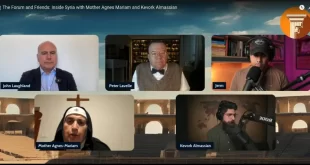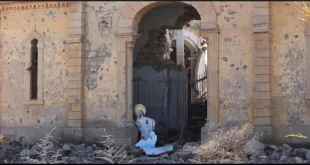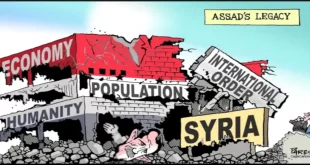Apr 21 2016, Crescent International
-Ken Stone, Liberated Palmyra
Ken Stone, executive member of the Syria Solidarity Movement (syriasolidaritymovement.org) and a longtime antiwar activist, was among the first foreigners to enter the historic city of Palmyra after its liberation from the takfiri terrorists at the end of March. Below we give his report from Palmyra. In the photo, Syrian families with their belongings retrieved from their homes can be seen standing in the street.
Until today, our Second Tour of Peace had not been exposed to any semblance of military combat. We hadn’t heard a single rifle shot or the thud of any bombs or artillery shells. We hadn’t seen any armoured vehicles or warplanes in action in any of the liberated areas we travelled in Syria. In fact, in the government-held areas, you really wouldn’t notice there was a war going on (except for the endless checkpoints). The security situation in Syria, according to our hosts, had improved immensely since the agreement for a partial cessation of hostilities was signed in Geneva about five weeks ago.
Today would be a little different. Today, we were going to be the first group of tourists actually to tour the ancient site of Palmyra.
Like Damascus, Palmyra was a settlement built around an oasis in the desert. Both Damascus and Palmyra were important stops for caravans along the Syrian Silk Road. Palmyra was turned into a flourishing city, complete with two temples, an ampitheatre, and an arch of triumph by the Romans. It was renowned in the ancient world as “the bride of the desert.” Today, it has been declared a World Heritage Site by UNESCO (United Nations Educational, Scientific, and Cultural Organization). Ever since the site was liberated by the Syrian Arab Army in heavy fighting two weeks ago, in coordination with bombing by the Russian air force, and support from Iranian, Hezbollah (Lebanon) and Palestinian allies, everybody in Syria wants to go there and see for himself and herself just how much damage the terrorist mercenaries caused. But it’s up to the Russian sappers to say when the site will be open to the general public.
Russian sappers have been working tirelessly to remove thousands of landmines and booby-traps both in ancient Palmyra and the adjoining modern town of Tadmor. Just when they think they have removed or exploded the last ones, a few more are found and the opening of the site and town has to be delayed. Our tour organizers have been on the verge of being granted the necessary permits from the Russians for four straight days only to be told, for three days, at the last moment, that we couldn’t go.
To go to Palmyra, one must first pass through Tadmor. On the way into Tadmor is a gruesome sight: the burnt and headless body of an ISIS terrorist lying beside the road. His rib cage is partially exposed and his skin and toes are blackened. The Syrians are certain he’s not one of theirs and so haven’t been in a hurry to deal with him. I get the feeling that he is a macabre sort of collective souvenir for the Syrian soldiers of the two battles for Palmyra: one tenth months ago when ISIS troops travelled hundreds of kilometres from Homs, from Iraq, and from Raqqa all the way to Palmyra in open convoys without the US-led coalition dropping a single bomb or firing a shot at them. About two hundred Syrian soldiers were killed in the unsuccessful battle to protect Palmyra ten months ago and about two hundred more to liberate it a few days ago.
If it had been the US-led coalition that had liberated Palmyra, you can bet that every mainstream news outlet in the western world would have been crowing about it at the top of their lungs. But, because it was the Syrians and Russians instead, the reaction to the salvation of Palmyra from ISIS, a victory of civilization over barbarism, was extremely muted in the West.
The devastation of housing in Tadmor reminds us in the solidarity delegation of the old city of Homs but now there is a new twist. We have arrived on the day that the Syrians and Russians have permitted the inhabitants of Tadmor to return to the ruins of their own homes to evaluate the damage and to try and salvage what they can. The streets are lined with buses and trucks stuffed with clothing, appliances, carpets, furniture of all kinds, toys, mattresses, mirrors, vaccuum cleaners, all the stuff you would try to save from your house had it been damaged or destroyed. The stuff is coming out of the windows of the buses and is tied down in huge bundles on the roofs of the trucks.
We, in the delegation, are overwhelmed with sadness at this sight. But not so the inhabitants of Tadmor. One of the tour organizers walks up to a family at random on the sidewalk sorting through a mound of stuff they have laboriously hauled all day from the ruins of their home perhaps a block away or more. The organizer greets the patriarch of the family in Arabic and asks how the family is coping.
The patriarch in turn looks up from his work and, unexpectedly, smiles broadly. He declares, “Not to worry! Everybody is better now that the takfiris (jihadi terrorists) have gone! And the living will be better too. We will rebuild the town and it will be twice as good as before!”
Wow! The resilience of these Syrian people!
The family gets quickly back to work because the Russians have given them a time limit to pack up and leave town.
Finally, our tour bus rolls into the square in front of the museum of Palmyra. Antoine Mamarbachi, our tour guide, steps off the bus and starts walking in circles, as if in a catatonic state, muttering repeatedly, “Oh, my god, my god!” Most of the museum’s smaller priceless artifacts had been removed and hidden by the government at the start of the war but the larger pieces that were too big to be moved now lay broken and scattered in front of us, including beautiful statues and intricately carved capitals. A team from the antiquities department has already cataloged them with numbered labels.
Across the street from the museum were a police station and a restaurant. Both have been levelled. From this spot, Antoine points out where the Temple of Bel and the Arch of Triumph had stood, now reduced to rubble.
Antoine has led over 300 sightseeing trips to Palmyra during his long career as a guide and is a walking encyclopedia of the cultural history of Syria. He has had his handkerchief handy because he was sure he was going to cry at the sight of the destruction of this former jewel of humanity’s collective cultural heritage. But he didn’t. He sighs melodramatically and observes instead, “There are just not enough tears left in all of Syria to weep for this.”
And that’s probably because the good news is that UNESCO has already agreed to work in cooperation with the Hermitage Museum of St. Petersburg, Russia, to rebuild and restore the temples and the arch of triumph.
So, Antoine resumes his duties as guide and walks us through the colonnade and the ampitheatre showing us the best angles to take photographs, taking advantage of the long shadows of late afternoon. I, for one, am extremely careful to walk only where Antoine has walked and not to venture where there might be unexploded mines.
A high level Russian military party is on the site. We are not allowed to approach. No photos either. The party is surrounded by big burly commandos, armed with AK 74’s and wearing earpieces among a ton of other gear. Their gloved fingers are on the trigger guards of their assault rifles. They don’t return smiles the way Syrian soldiers do. Their bodies are taut. They are on edge. You don’t want to mess with these guys.
“Congratulations!” states Antoine after about ninety minutes, “you are the first tourists actually allowed on the site of the ancient city. But your political pilgrimage is over. It’s time to go.”
On the way out of town, we pass a building that has been taken over by the Russian de-mining team as a clubhouse. There is a big red banner over the door that says, simply, in handpainted Cyrillic letters: “SAPPERS!”
Just as we pass the Sapper’s Club, there is a series of twenty or so very loud detonations from the other side of Tadmor and plumes of black smoke rise in the sky: the sappers have detonated some more mines or booby traps in the town. This is followed by two short bursts of small arms fire. Of what that meant, I have no idea.
It’s a long way back to Damascus on this, our last day of the tour, which also happens to be Syrian Independence Day. Jeffrey Klein and I have been invited to appear as guests of Hanna Alsaleh on her current affairs show, “Pulse of the Orient”, at SAMA, a private Syrian television station.
Near the end of the program, Hanna asks me what I thought of the tour. I reply that I was, like Jeff, overwhelmed by the friendliness, generosity of spirit, and hospitality shown to us by every single Syrian, of every walk of life, we had met during the week. But more than that, I was surprised at the resilience of the Syrian spirit. I expect to find Syrians depressed, exhausted, and pessimistic after five long years of war. Instead, they were full of life and defiance. They defiantly held an election. They were creating ambitious plans to reconstruct their lives. The restaurants and nightclubs were full of people at night and they were singing patriotic songs and dancing. Because of this, I too was imbued with their spirit of optimism about the future of Syria.
For five years, I stubbornly followed the western aggression against Syria without much hope that things would end any differently than in Yugoslavia, Afghanistan, Iraq, Libya, Haiti, or Somalia. But now, since the Russian military and diplomatic offensive of last September 30th, I see for the first time some light at the end of the tunnel for Syria. Since that offensive, we no longer live in a unipolar world where the USA has full spectrum dominance over everyone else. That offensive, along with enormous and continuing help from Iran, Hezbollah, as well as Palestinian fighting units, has forced the USA to the bargaining table over the future of Syria.
It’s my opinion that Russia, China, Iran, and Hezbollah have collectively drawn a red line around Syria and won’t let it fall to the terrorists. After all, if they did, it would mean that the terrorists would soon be at the gates of Beirut and Tehran, and, not long after that, be marching on Moscow and Beijing.
So, yes, I am cautiously optimistic that Syria will win back its national sovereignty and territorial integrity. Just don’t ask me when. The USA is still toying with its “Plan B” for regime change and taking advantage of the current partial pause in the fighting to rearm its “moderate” terrorists with anti-aircraft weapons. Nonetheless, Syria will triumph, because Syrians are resilient and have powerful allies. And they have the added strength of fighting for a just cause, which attracts the solidarity of people and movements around the globe. The just cause is their own liberation against an illegal foreign aggression and occupation and the demand that international law in respect to Syria be respected.
The Syrians have fought with their backs to the wall for the past five years. And they are still fighting for all of us. They deserve our support.
SEE ALSO:
 Syria Support Movement solidarity with the Syrian people
Syria Support Movement solidarity with the Syrian people





